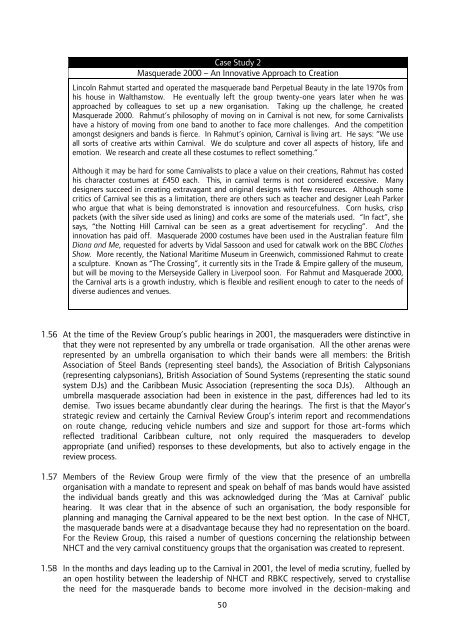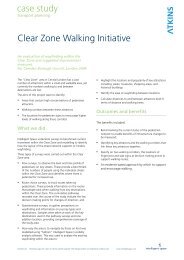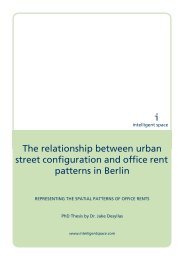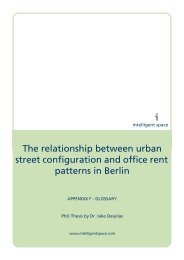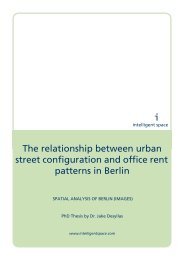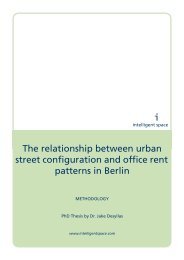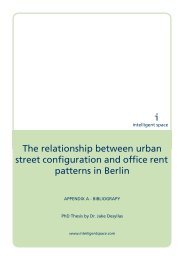Notting Hill Carnival Strategic Review - Intelligent Space
Notting Hill Carnival Strategic Review - Intelligent Space
Notting Hill Carnival Strategic Review - Intelligent Space
You also want an ePaper? Increase the reach of your titles
YUMPU automatically turns print PDFs into web optimized ePapers that Google loves.
Case Study 2<br />
Masquerade 2000 – An Innovative Approach to Creation<br />
Lincoln Rahmut started and operated the masquerade band Perpetual Beauty in the late 1970s from<br />
his house in Walthamstow. He eventually left the group twenty-one years later when he was<br />
approached by colleagues to set up a new organisation. Taking up the challenge, he created<br />
Masquerade 2000. Rahmut’s philosophy of moving on in <strong>Carnival</strong> is not new, for some <strong>Carnival</strong>ists<br />
have a history of moving from one band to another to face more challenges. And the competition<br />
amongst designers and bands is fierce. In Rahmut’s opinion, <strong>Carnival</strong> is living art. He says: “We use<br />
all sorts of creative arts within <strong>Carnival</strong>. We do sculpture and cover all aspects of history, life and<br />
emotion. We research and create all these costumes to reflect something.”<br />
Although it may be hard for some <strong>Carnival</strong>ists to place a value on their creations, Rahmut has costed<br />
his character costumes at £450 each. This, in carnival terms is not considered excessive. Many<br />
designers succeed in creating extravagant and original designs with few resources. Although some<br />
critics of <strong>Carnival</strong> see this as a limitation, there are others such as teacher and designer Leah Parker<br />
who argue that what is being demonstrated is innovation and resourcefulness. Corn husks, crisp<br />
packets (with the silver side used as lining) and corks are some of the materials used. “In fact”, she<br />
says, “the <strong>Notting</strong> <strong>Hill</strong> <strong>Carnival</strong> can be seen as a great advertisement for recycling”. And the<br />
innovation has paid off. Masquerade 2000 costumes have been used in the Australian feature film<br />
Diana and Me, requested for adverts by Vidal Sassoon and used for catwalk work on the BBC Clothes<br />
Show. More recently, the National Maritime Museum in Greenwich, commissioned Rahmut to create<br />
a sculpture. Known as “The Crossing”, it currently sits in the Trade & Empire gallery of the museum,<br />
but will be moving to the Merseyside Gallery in Liverpool soon. For Rahmut and Masquerade 2000,<br />
the <strong>Carnival</strong> arts is a growth industry, which is flexible and resilient enough to cater to the needs of<br />
diverse audiences and venues.<br />
1.56 At the time of the <strong>Review</strong> Group’s public hearings in 2001, the masqueraders were distinctive in<br />
that they were not represented by any umbrella or trade organisation. All the other arenas were<br />
represented by an umbrella organisation to which their bands were all members: the British<br />
Association of Steel Bands (representing steel bands), the Association of British Calypsonians<br />
(representing calypsonians), British Association of Sound Systems (representing the static sound<br />
system DJs) and the Caribbean Music Association (representing the soca DJs). Although an<br />
umbrella masquerade association had been in existence in the past, differences had led to its<br />
demise. Two issues became abundantly clear during the hearings. The first is that the Mayor’s<br />
strategic review and certainly the <strong>Carnival</strong> <strong>Review</strong> Group’s interim report and recommendations<br />
on route change, reducing vehicle numbers and size and support for those art-forms which<br />
reflected traditional Caribbean culture, not only required the masqueraders to develop<br />
appropriate (and unified) responses to these developments, but also to actively engage in the<br />
review process.<br />
1.57 Members of the <strong>Review</strong> Group were firmly of the view that the presence of an umbrella<br />
organisation with a mandate to represent and speak on behalf of mas bands would have assisted<br />
the individual bands greatly and this was acknowledged during the ‘Mas at <strong>Carnival</strong>’ public<br />
hearing. It was clear that in the absence of such an organisation, the body responsible for<br />
planning and managing the <strong>Carnival</strong> appeared to be the next best option. In the case of NHCT,<br />
the masquerade bands were at a disadvantage because they had no representation on the board.<br />
For the <strong>Review</strong> Group, this raised a number of questions concerning the relationship between<br />
NHCT and the very carnival constituency groups that the organisation was created to represent.<br />
1.58 In the months and days leading up to the <strong>Carnival</strong> in 2001, the level of media scrutiny, fuelled by<br />
an open hostility between the leadership of NHCT and RBKC respectively, served to crystallise<br />
the need for the masquerade bands to become more involved in the decision-making and<br />
50


